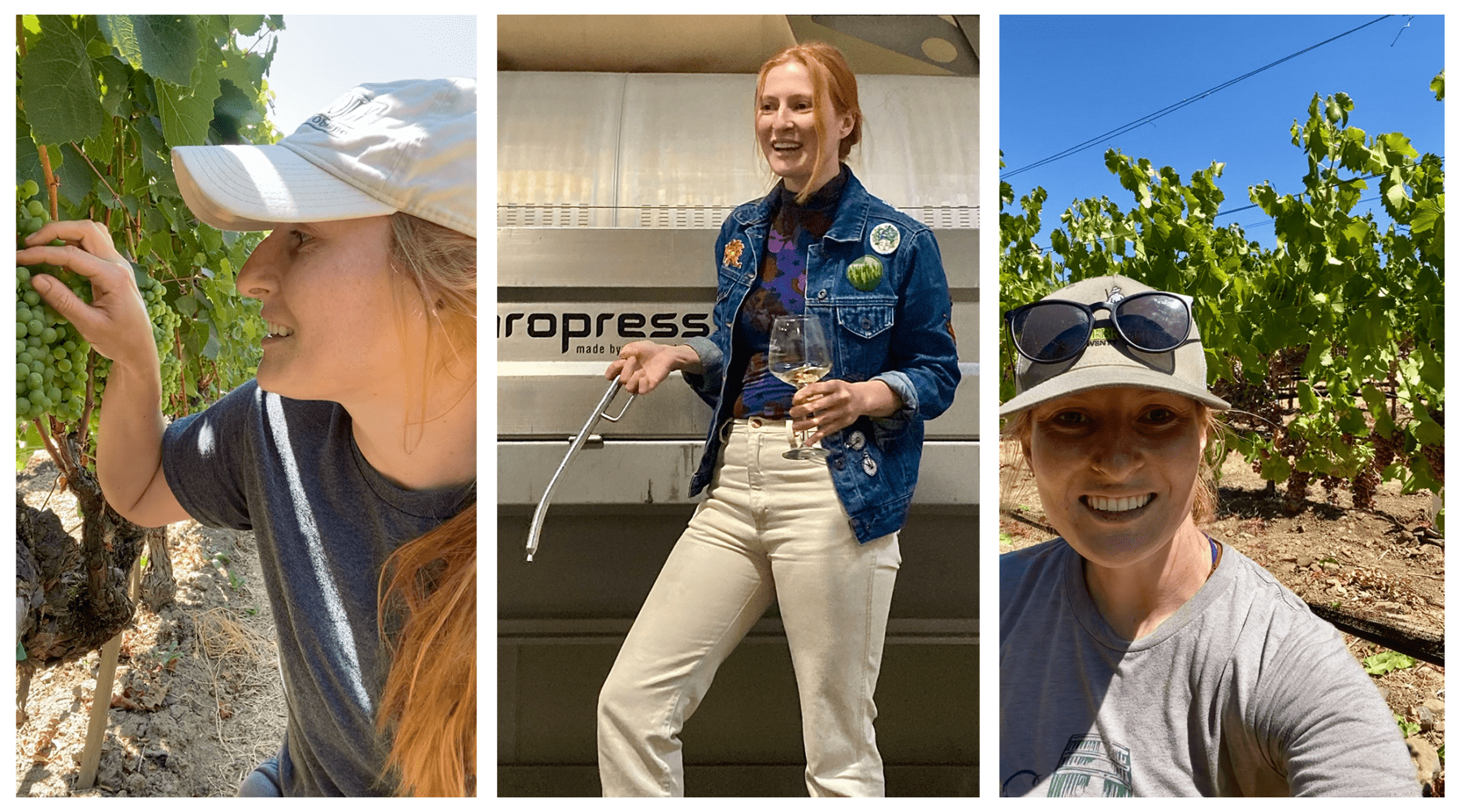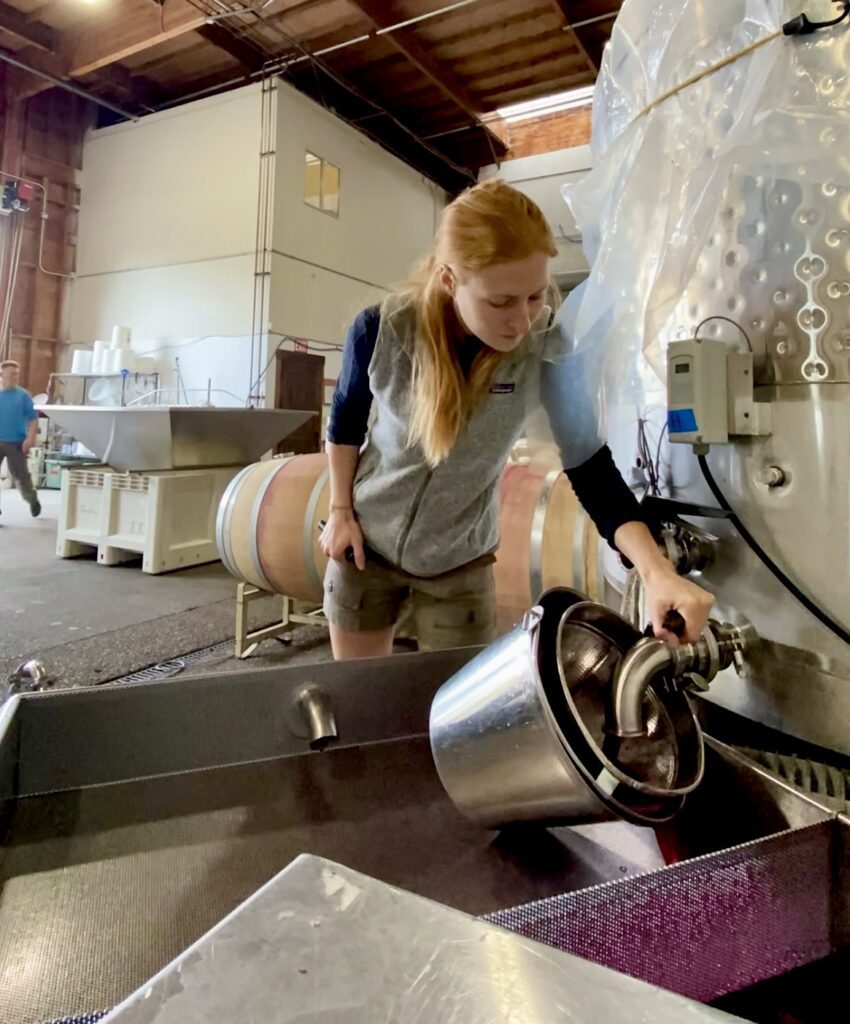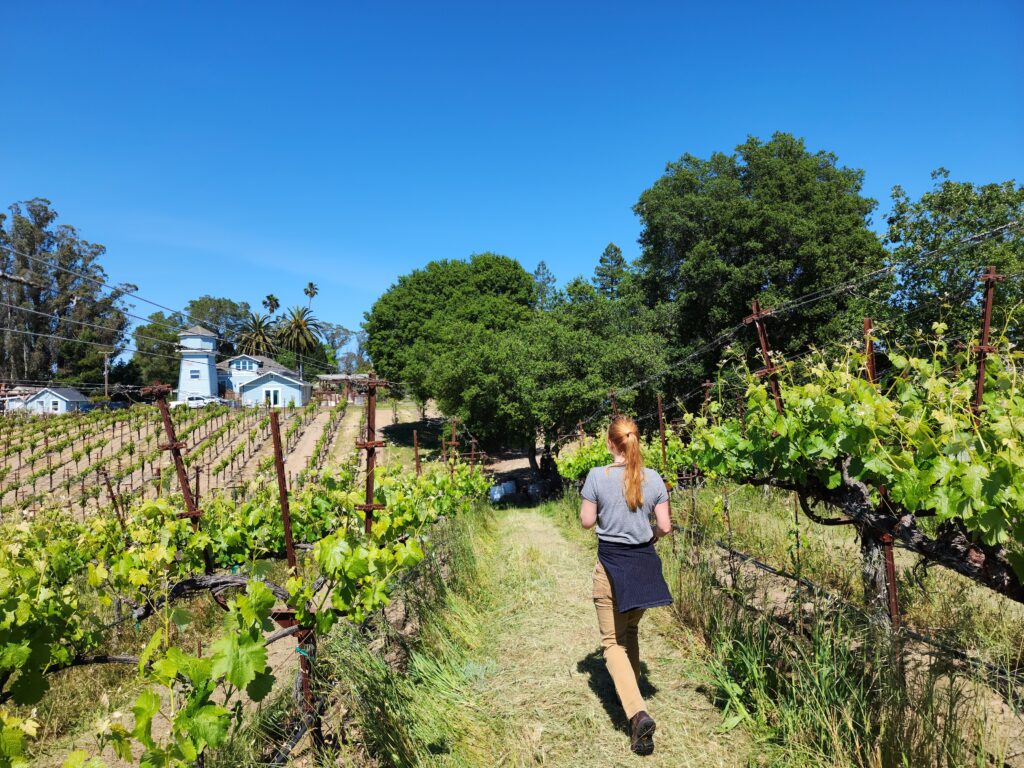
What is a Cellar Master? 21 Questions with Maya Joye
The title “Cellar Master” might raise an eyebrow when you first hear it. It’s one of those wine industry terms that’s very Old World, and it sounds like a position in a medieval royal court. According to Merriam-Webster, a Cellar Master is “a person who supervises the making of wine in a winery”—a definition that, while true, feels both broad and vague. From sampling fruit and tending vines to cleaning equipment, driving forklifts, performing lab work, recording data, and assisting with every stage of turning grapes into wine, a Cellar Master really does it all. Depending on the winery’s size and team, the role can vary—large wineries might have several, while smaller wineries like ours rely on just one.
Meet Maya Joye, our Cellar Master and Winemaker David Milner’s right hand. A jill-of-all-trades, Maya joined Donelan almost two years ago and immediately proved to be the perfect fit. With her attention to detail, passion, resourcefulness, and tireless work ethic, she has everything a good Cellar Master needs. While many people have no idea who is involved behind the scenes at a winery, we’re here to give you a closer look at the Donelan Family Wines team. We sat down with Maya during the busy 2024 harvest season for a fun round of 21 Questions.

Maya at work in the winery
1. Have you ever been a Cellar Master before? How would you describe your job?
Before starting at Donelan I was the Cellar Master at Crocker & Starr in St Helena, CA. Being Cellar Master at a small winery is a position where you inevitably wear a lot of hats. One day I’m leafing the vineyard, the next I’m repairing the plug on our pump, or checking the alcohol percentage on the wine we’re blending. I have my hands on all aspects of the winemaking process, from vineyard through to bottling, executing David’s vision for the wine.
2. What does your ideal workday look like?
One of the things I love about my job is that I get a good mix of time in the vineyards along with the cellar. My ideal workday would be starting out in the vineyard, sampling for maturity or checking for budbreak, then heading back to the winery to run some lab analysis or do some cellar work, and then pulling barrel samples for a blending session with David.
3. Is there any task you dread doing?
Once in a blue moon, a macro-bin will slide off the forks when we’re dumping stems or pomace in the compost dumpster. Digging the bin back out means climbing in the dumpster with all the fruit flies and yellow jackets. I hold my breath every time I have to dump a bin of stems.
4. How has harvest been this year? Highlights? Challenges? Any big differences compared to your first Donelan harvest last year?
It’s been a great harvest so far. Mother Nature has been working in our favor this year. We’ve had waves of heat through the season, each one pushing a couple of vineyards to the finish line at a time. So the fruit has matured in bursts, coming in at a nice metered pace while allowing for good hangtime. Very different from last year, when the cooler-than-average season meant we were crossing our fingers that all the vineyards would ripen fully.
5. Do you look forward to harvest or prefer calmer seasons?
While I miss the parts of my life that are put on hold during harvest – time with family and friends, my hobbies, my gym routine – there’s something about harvest that has kept me coming back for eleven seasons now. With our attention so focused on making wine, it’s like the rest of the world goes quiet. It feels like an older way of living, being in touch with the seasons and the weather, and just taking one day at a time.
6. Anything you’d love to try doing at work that you haven’t yet?
We have a new piece of lab equipment. It’s an automated analyzer that will increase our ability to run in-house wine analysis. We’ll be getting it up and running this month, and once we do so, we’ll be able to track fermentations, wine acidity levels, grape maturation, and so much more. I love the chemistry part of making wine, so I am very excited for this new tool.

Maya in the lab running analysis
7. Is there anything at Donelan that’s been a unique or first-time experience for you so far?
Over the years, David has collected extensive data on each of our vineyards. He tracks the dates when budbreak, flowering, and veraison occur in each of our vineyards, so he can compare year-to-year data. By doing so we can better predict when we’ll harvest each block, and compare how the vintage will stack up to the ones that came before. Being so in touch with each of our vineyards is really rare and has helped me get to know each terroir, variety, and vintage.
8. Do you aspire to be a Winemaker one day?
I’ve wanted to be a winemaker since I was thirteen. I don’t really think I knew what it entailed at that age, but I’ve been chasing that dream ever since.
9. You’ve told us before that you love Northern Rhone varietals, but your favorite Donelan wine is the Tripp’s Block Pinot Noir. What would you pair with Tripp’s Block? If it were a song, what would it be?
I think Tripp’s Block would be lovely with a mushroom risotto to complement its lithe body and earthy profile. If it was a song, it would be Dreams by Fleetwood Mac; it’s down-to-earth, a little bit wild, and true to its roots.
10. Do you have a least favorite varietal?
I hate to say it, being a California gal, but probably Zinfandel. I’ve had (and helped make) some really incredible bottles of Zinfandel, but I don’t tend to gravitate towards it when I’m opening a bottle of wine at home.
11. What are you drinking if you’re not drinking wine?
Usually a gin and tonic or a local IPA, but I did enjoy the Hugo spritz trend this summer.
12. Do you like to cook?
I love to cook and bake, especially around the holidays when I’m in the kitchen with my family and we have time to do big communal projects like tamales or homemade pasta. For Thanksgiving, I always make my specialty pumpkin pie with a gingersnap crust.
13. Sonoma County has some awesome restaurants. Do you have any favorites?
My top three spots in Sonoma County are probably El Molino Central in Sonoma, Ramen Gaijin in Sebastopol, and Sol Food in Petaluma.
14. You’ve worked in wine regions all over the world. Do you have a favorite? How does it compare to Sonoma?
After my time in South Australia, I have to say McLaren Vale is pretty high on my list, they grow so many fun varieties and make some incredible wines, but because it’s next to the beach it has a laid-back feel to it. It’s like Sonoma County’s wild child of a sibling.
15. Wine region you’ve never been to but is at the top of your list to visit?
It’s a long list – the Rhone Valley, Piedmont, Mendoza, Margaret River, Tasmania. But I really want to go to the Mosel in Germany, where there are so many amazing producers in one of the most beautiful grape-growing regions in the world. Second on the list would be to go back to the Canary Islands to visit the vineyards in Lanzarote, for the incredibly unique terroir.
16. You spent a year of high school in the Canary Islands and that’s where you got interested in food and wine. What was that like?
While I had the chance to meet winemakers and eat at some incredible restaurants, the most lasting impact came from the time I spent around the kitchen table with my host family. We would go over to my host mother’s family home, where they would cook paella in a huge paella pan outside. They had a 30-foot-long table in the basement where the whole extended family could sit together, peeling the skins off of prawns with our hands, sharing local wines and stories. Some of the best meals of my life were eaten at that table.
17. What would be your advice for a young person who’s interested in wine but maybe doesn’t know where to start?
The best advice I got during my freshman year at Cal Poly was from a professor who told us to start developing our palate even before we could taste wine. He told us to go to the grocery store and smell the produce and memorize the aromas. I call it my file folder of flavors, and anytime I’m trying to describe a wine I flip through it mentally to place an unidentified note. Also, learn to back up a trailer.

Maya at Kobler Vineyard
18. Has anyone in your family worked in wine, or are you the first? Was it an unexpected path for you to take or did it seem like a natural choice?
It was fairly unexpected since I’m from Silicon Valley, so not exactly a winemaking hot spot. My grandfather was a home winemaker, but I’m the first to work in the industry professionally. It was a unique path but it’s been a great fit for me.
19. Who are your role models?
I have had the opportunity to work with and learn from a number of incredible people in this industry. Early on I worked under Shane Moore at Gran Moraine and Cody Rasmussen at Bedrock Wines, both of whom influenced the philosophy with which I approach winemaking. Evyn Cameron, the first winemaker I worked side by side with, taught me more than anyone else. And my friend Katelyn Van Winkle, the assistant winemaker at Schramsberg, who I consider my top peer role model.
20. Things you’re passionate about aside from wine?
I joke that my hobby is just picking up new hobbies – but really I just love learning something new. I always have a project, usually more than one. Currently, I’m building my boyfriend a shelving unit for his golf equipment – though that project has been on hold during harvest.
21. David Milner is a good teacher. Has he given you any advice that has stuck with you?
David is constantly saying “There’s always a reason” by which he means behind every manipulation – a racking, a blending, a co-fermentation, etc. – we make to a wine, there is a well-thought-out, data-driven reason behind it. We don’t do anything “just because” or because that’s how it’s always been done. There’s always a reason, and usually one he has put hours and hours of thought into.



